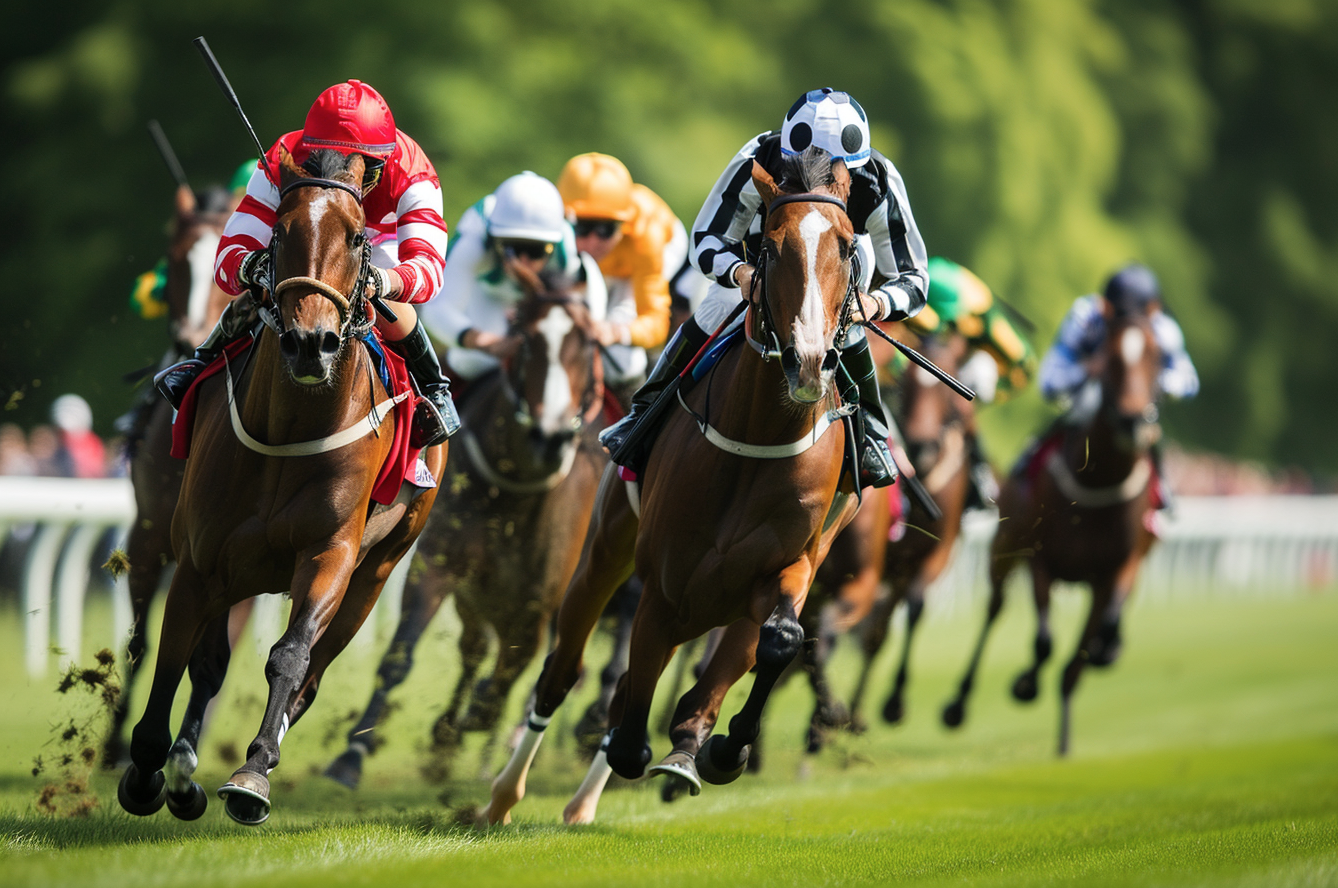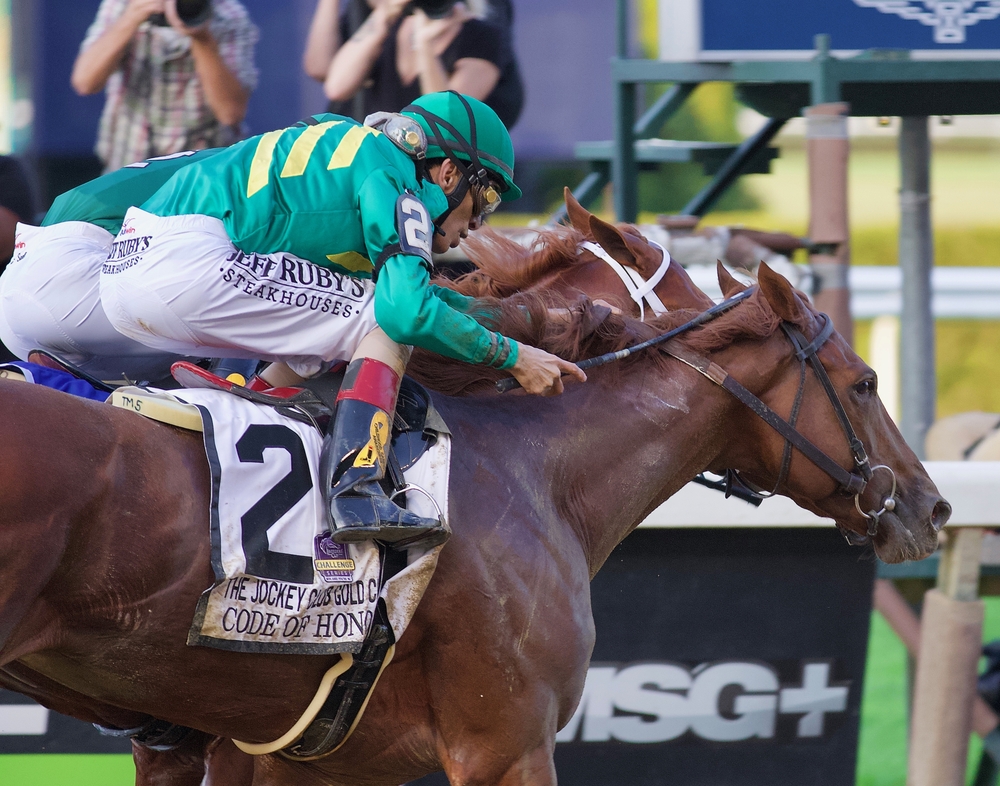In the realm of horse racing, a fall can occur when a horse and jockey make a mistake while navigating an obstacle, leading to the horse dropping to the ground. These incidents are more commonly associated with National Hunt racing, which involves jumping over fences and hurdles, than with flat racing. As a measure of safety and to inform betting decisions, these instances are denoted with an ‘F’ on race cards and can significantly impact the outcome of a race, as well as having welfare implications for both horse and jockey.
The frequency of falls in horse racing is an indicator of numerous factors, including the difficulty of the course, the condition of the turf, and the experience of the jockey. On average, the likelihood of a horse falling is relatively low, but certain races or conditions can see a higher incidence. The aftermath of a fall can vary, with many horses and jockeys getting back on their feet quickly; however, there’s always a risk of injury. Those within the racing community, from the regulatory bodies to the trainers, continually work to minimise these risks and ensure the welfare of everyone involved in the sport.
Key Takeaways
- Falls in horse racing are mostly associated with National Hunt racing due to the jumping element involved.
- Several complex factors, including course conditions and jockey experience, contribute to the frequency of falls.
- The horse racing industry is actively engaged in efforts to reduce the incidence of falls and enhance safety measures.
Understanding Horse Racing
Horse racing is a sport with multi-faceted disciplines, prestigious events, and a stringent set of rules ensuring fairness and safety.
Disciplines Within Horse Racing
Within the realm of horse racing, there are primarily two disciplines: flat racing and jumps racing, which is also known as National Hunt racing. The former is characterised by races on a flat, level track without any obstacles, ranging in distance from 5 furlongs to over 2 miles. It is a test of speed and stamina, with the world’s finest thoroughbred horses competing.
In contrast, jumps racing includes hurdle races and steeplechases, where horses must navigate a variety of obstacles. Hurdle races feature smaller jumps, whereas steeplechases present a more challenging array of larger fences and ditches. National Hunt racing combines both disciplines, featuring a series of races that are typically conducted during the winter months.
Key Racing Events
The horse racing calendar is studded with key events that capture the public’s imagination. Amongst the most prestigious are:
- The Cheltenham Festival: A pinnacle in the National Hunt season, this event showcases some of the best jumps racing.
- The Grand National: Held at Aintree, it’s a demanding steeplechase, famous for its difficulty and the test of endurance it poses both for the horse and jockey.
- The National Hunt Chase: Another highlight in the National Hunt calendar.
These events are not just sporting spectacles but also significant occasions for the racing community and the public alike, attracting large crowds and betting interest.
Rules and Regulations
The British Horseracing Authority (BHA) governs the sport, implementing and enforcing the rules and regulations to ensure safety and fairness. Key rules include:
- Race starts: All race starts must be fair and without advantage to any horse.
- If a horse refuses, falls, is pulled up, or the jockey is unseated, they cannot continue in the race.
Participation in the sport requires adherence to these regulations, and both trainers and jockeys must be licensed and knowledgeable of the rules. Compliance is essential for the wellbeing of the horses and the credibility of the sport.
Prevalence of Falls in Horse Racing
Fall incidents in horse racing are a point of concern for jockeys, trainers, and spectators. These occurrences can vary based on the type of race and the condition of the horses and tracks.
Statistics on Horse Falls
In National Hunt racing, which encompasses steeplechasing and hurdling, falls can range between 1 in 10 to 1 in 14 runners in UK chase races. Data suggests variations across seasons, with fall percentages peaking at 9.6% and dropping as low as 7.1%. Jockey falls in international horse racing occur at a rate of 3 to 4 per 1,000 rides. Outcomes of these falls can be severe, with a notable proportion resulting in injury or fatality of jockeys.
| Season | Fall Rate (%) | Jockey Fall Rate (per 1,000 rides) |
|---|---|---|
| 2005/06 | 9.6 | 3 – 4 |
| 2012/13 | 7.1 | N/A |
| 2013/14 | 7.1 | N/A |
Examining Different Types of Falls
Fallers in races can be attributed to various causes, such as inexperience or tiredness. A fell horse refers to those that tumble during the race, while unseated riders are situations where jockeys are thrown from the horse without it falling. Brought down reflects instances where a horse falls as a result of another faller. Different types of races present unique challenges leading to falls, with steeplechase races having higher numbers of falls due to more complex fences and longer distances.
Factors Contributing to Falls
In assessing why horses fall in horse racing, it is crucial to consider the impact of man-made obstacles, the animals’ physical and psychological readiness, and varying external conditions that affect the racecourse.
The Role of Obstacles
Obstacles such as hurdles and fences are integral to National Hunt racing and steeplechases. These barriers vary in height and complexity, with fences generally being larger and more solid than hurdles. A horse’s ability to navigate these obstacles is paramount; however, inexperience can lead to misjudgment and falls. Additionally, the density of jumps on a racecourse can increase the likelihood of a fall, putting horses at risk if they cannot recover quickly from a jump before approaching the next one.
Physical and Psychological Aspects
Horses’ physical condition and mental state are critical in preventing falls. Inexperience can lead to anxiety or hesitation before jumps, while a horse’s tiredness towards the end of a race can result in a loss of concentration and coordination. It is important to note that younger horses or those with less racing exposure are more prone to falls due to a lack of experience and developed ability.
External Conditions
Racecourses are subjected to various weather conditions, with certain trackers tending to become slippery during wet weather, increasing the risk of falls. Additionally, the ground’s firmness can vary, affecting horses’ grip and stability. Spectators and the overall race environment can also contribute to a horse’s psychological stress, potentially impacting their performance and increasing the risk of accidents.
Impact of Jockey Experience
The performance and safety records in horse racing events are significantly influenced by the expertise of the jockey. Experienced professionals tend to have fewer falls, benefiting both themselves and their horses, while amateur jockeys face challenges that can increase the risk of incidents during a race.
Expertise of Professional Jockeys
Professional jockeys possess a combination of skills that are crucial for both the prevention of falls and the successful outcome of races. Experience plays a pivotal role, as seasoned jockeys exhibit better race intuition and decision-making abilities. For instance, distinguished jockeys like Ruby Walsh have set high standards for jockey performance through their careers. Professionals are also more adept at maintaining control over their mounts during unexpected race developments, resulting in a lower incidence of accidents. Their physical fitness helps them to resist fatigue, which is a contributing factor in maintaining balance and preventing falls. Owners and trainers generally prefer to work with professional jockeys as they can more confidently manage the horses, leading to better race day results.
Challenges Faced by Amateur Jockeys
In contrast, amateur jockeys often encounter difficulties due to inexperience. A lack of race exposure can lead to poorer judgement and slower reaction times, attributes that increase the likelihood of falls. Inexperience with different racecourses and conditions can also pose a risk to both horse and rider. Lack of familiarity with the subtleties of race strategies often used by professionals further disadvantages amateur riders. These factors combined suggest that amateurs have an elevated risk of encountering accidents on the track, which can have direct implications for the health and well-being of both the jockeys and their horses. Trainers and owners must balance the potential for growth and development in amateur jockeys against these inherent risks.
Betting and Public Perspective
The intersection between betting dynamics and public concerns plays a critical role in horse racing. Bettors scrutinise race cards and odds with an eye on safety measures and the welfare of horses and riders.
Effect of Falls on Betting Odds
Bookmakers adjust betting odds in horse racing based on various factors, including the track’s condition and historical fall rates. Punters may observe that as the risk of falls increases, possibly reflected in past statistics or the degradation of the course over the day, odds for certain horses may lengthen. Online bookmakers often provide up-to-date odds, taking into account the likelihood of falls, which may impact potential returns in pounds. It’s crucial for bettors to consider safety records and the probability of falls when making bets, as these elements directly correlate with the unpredictability of outcomes.
Public Concerns About Horse and Rider Safety
The public’s concern for the safety of both horse and rider can significantly influence their betting behaviour and the perception of the sport. Safety measures, such as improved helmets and better track maintenance, are often scrutinised by bettors. Injuries and, more tragically, horse deaths, can impact the public’s view of the sport, prompting some to call for increased safety protocols. The welfare of the animals is a paramount concern for many spectators, and their expectations often translate into pressure on race organisers and regulatory bodies to uphold and enhance safety standards.
Safeguarding Horses and Riders
In the realm of horse racing, the safety of both horses and riders is paramount. Regulatory bodies such as the British Horseracing Authority (BHA) implement stringent safety measures and oversee veterinary care, aiming to minimise risks and ensure the well-being of all participants.
Safety Measures and Precautions
The BHA has established comprehensive safety protocols to protect horses and jockeys during races. These include:
- Course Inspections: Rigorous pre-race checks to ensure the track is in optimal condition, reducing the likelihood of accidents.
- Fence Design: Fences used in jump racing are constructed to be as safe as possible while still presenting a challenge to competitors.
- Rider Equipment: Mandatory use of helmets and body protectors to safeguard riders from falls and injuries.
- Fallen Horse Procedures: Protocols are in place to manage situations when a horse falls, including immediate on-site veterinary attention and faller insurance provisions.
Veterinary Care and Monitoring
Consistent monitoring and post-race checks play a critical role in the welfare of racehorses. Key practices implemented include:
- Pre-Race Veterinary Inspection: Horses are examined by veterinarians prior to racing to ensure they are fit to run.
- During Race Monitoring: A team of veterinarians is present during races to provide immediate assistance if required.
- Post-Race Checks: Horses receive a thorough examination after a race to detect any signs of stress or injury and to administer any necessary treatments promptly.
Aftermath of a Fall
When a horse falls during a race, the primary concern is the safety and well-being of both the horse and the jockey. Immediate action is taken to provide medical attention, while subsequent steps involve thorough investigations to understand the causes and implications of the fall.
Immediate Response and Medical Attention
Upon a fall, emergency services are dispatched instantly with the utmost urgency. Medical teams, including veterinarians and paramedics, rush to the scene to assess the condition of the horse and jockey. The racetrack’s experienced medical staff are trained to deal with such incidents promptly. If injuries are detected, further treatment is provided on the spot, or the affected parties are transferred to specialist facilities for comprehensive care. The well-being of the horse and jockey always takes precedence, and their health is closely monitored in the minutes and hours following the incident.
Investigations and Follow-Up Actions
After initial medical assessments and care, the British Horseracing Authority (BHA) typically undertakes a detailed investigation to discover the root cause of the fall. They review race footage, examine the conditions of the track, and evaluate the performance of the horse and jockey before the fall. Any findings are used to inform future safety measures and practices. Follow-up actions may include adjustments to race conditions, improvements in jockey training, or modifications to track maintenance protocols. The goal is to reduce the likelihood of similar incidents in the future, ensuring the safety of all race participants.
Historical Context and Famous Falls
Throughout the history of horse racing, falls have shaped the sport, leading to safety innovations and unforgettable moments. The Grand National and Cheltenham Festival, with their challenging chase and hurdle races, have witnessed some of the most significant incidents.
Memorable Incidents in Major Races
Grand National: This steeplechase is notorious for its difficulty and has been the site of many falls throughout its history. The fences at Aintree are larger and more demanding than those found in most other races, which has contributed to memorable, sometimes controversial, moments.
- Foinavon (1967): An iconic moment where a rank outsider won after a mass pile-up caused by a loose horse at the 23rd fence, leading to almost all horses being obstructed.
- Red Rum (1973, 1974, 1977): This famous horse triumphed at the Grand National three times, a testament to both skill and safety, as falls in this race can often lead to severe consequences.
Cheltenham Festival: Known for its hurdle and chase races, this event has seen its share of dramatic tumbles, affecting outcomes and sparking discourse on race safety.
- Annie Power (2015): At the Mares’ Hurdle, Annie Power had a fall at the last hurdle when leading comfortably, adding a dramatic twist to the race and highlighting the unpredictability of hurdle races.
- Benie des Dieux (2020): A similar incident to Annie Power’s, this mare fell at the last hurdle in the Mares’ Hurdle, which led to discussions about the risks involved in such jump racing events.
Lessons Learned from Past Events
Safety Measures: Falls in historic races have continually led to enhanced safety measures. Innovations such as improved hurdle design and modifications to chase courses at venues like Aintree have been instituted to reduce the risk of falls.
- The British Horse Racing Authority (BHA) has implemented amendments to race conditions, including reductions in field sizes and alterations to start procedures to enhance safety.
- Modifications to fences, like using more forgiving materials in the build and ensuring better ground conditions, have been crucial in reducing the number of horse falls during races.
Studying past events allows racing authorities and trainers to better understand the dynamics of falls, leading to ever-evolving strategies aimed at preventing accidents, thus safeguarding the welfare of both horses and jockeys.
Conclusion
In examining the frequency of falls in horse racing, available statistics indicate a small percentage overall. Falls in jump racing, specifically, have been recorded at an average rate of about 8%. Despite efforts by the British Horseracing Authority (BHA) to minimise risks, a fall rate of even 7.1%—the lowest observed in recent years—suggests that the inherent risks of the sport cannot be completely eliminated.
Safety measures have been a focal point for the industry. The decrease in horse fatalities—from 2.6 per 1,000 starts in 1994 to 1.8 per 1,000 starts in 2017—demonstrates a commitment to enhanced safety. Such improvements are the result of rigorous regulations, better track conditions, improvements in horse and rider training, and advancements in veterinary care.
Data further shows a variance in fall rates across seasons. For instance, the 2005/06 season saw a high of 9.6% fallers; however, this is not a static figure. The fluctuating data underscore the unpredictability of the sport and the continuous challenge for authorities to ensure equine welfare.
It is clear that while the risk of falls can be reduced through safety enhancements and vigilant practices, it remains an intrinsic part of the sport. The BHA and other regulatory bodies persist in their pursuit of creating the safest possible conditions for both horses and riders, with the understanding that complete eradication of falls is improbable.
Thus, the focus remains steadfast on ongoing efforts to reduce incidents through a multi-faceted approach that includes track safety, training methods, and horse welfare protocols.
Frequently Asked Questions
In horse racing, falls are a significant concern due to the potential risks to both horse and rider. Assessing the frequency and impact of these incidents requires access to recent data and understanding the precautions in place.
What is the frequency of falls in horse racing events?
The occurrence of falls in horse races varies by event and the type of racing. Jump racing, for example, has a higher incidence of falls compared with flat racing due to the presence of fences and hurdles.
What percentage of horses experience falls during races?
Exact figures fluctuate annually but generally, a small percentage of horses experience falls during races. Published statistics indicate that in jump racing, the risk is present, yet most races are completed without incident.
How common are injuries as a result of falls in horse racing?
Injuries can occur during horse racing, but comprehensive safety measures are designed to minimise their frequency and severity. While not all falls result in injury, immediate assessment and care are provided when necessary.
In the event of a horse falling, what are subsequent actions taken?
If a horse falls during a race, the priority is the safety of both the horse and rider. Medical and veterinary teams are on standby to provide immediate assistance, and an investigation is often conducted to understand the cause of the fall.
What safety measures are in place to protect horses in case of a fall?
Racecourses have strict safety protocols, including track maintenance, fence design, and pre-race checks. Additionally, riders wear protective gear, and horse ambulances are available to provide prompt care.
What are the implications for a race if all competing horses fall?
While exceedingly rare, if all horses were to fall in a race, the race would be voided and all bets cancelled. Rules stipulate that a horse must finish the course to be declared the winner.





